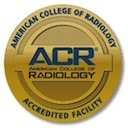Fluoroscopy
Fluoroscopy is a medical imaging technique used to examine your body internally using a device known as a fluoroscope. A fluoroscope consists of an X-ray source and a fluorescent screen between which the patient is positioned. Fluoroscopy provides images of internal organs and helps your doctor in evaluating your upper and lower gastrointestinal (GI) tracts.
Our imaging centers offer both upper and lower GI exams.
The upper GI exam, (upper gastrointestinal tract radiography) is an X-ray exam of the pharynx, esophagus, stomach and duodenum (part of the small intestine).
The lower GI exam, (lower gastrointestinal tract radiography, or barium enema) is an X-ray exam of the large intestine (colon) and sometimes the appendix.
Both exams use a contrast medium known as barium, or in some cases gastrograffin, which enhance the body area of interest.
A radiologist will be present during your exam to view the images as they are taken.
Your doctor will be able to give you additional details about the exam, but a general idea of what to expect is provided below.
Preparation
Tell your doctor if you are pregnant or suspect you may be pregnant. Your doctor may decide whether to postpone the exam or use an alternative exam to reduce the possible risk of exposing your fetus to radiation.
For upper GI exams – The night before your exam, do not eat or drink anything after 10:00 p.m. Refrain also from smoking or chewing gum prior to your exam.
For lower GI exams – The day before your exam, closely follow the EZ-EM prep package instructions provided by your doctor. The EZ-EM prep package is a liquid diet and laxative to clean your bowel to prevent obscuring or mimicking of abnormalities.
Exam
Our technologist and radiologist will prepare and guide you by explaining the procedure and positioning you to ensure the highest quality images are obtained from your exam.
Upper GI Exam
The exam is painless and typically takes between 15 to 20 minutes to complete.
You will be given a liquid contrast medium to drink during the exam. The contrast medium is a flavored mixture of barium sulfate and water. In addition, you may be given effervescent crystals with the contrast medium to further improve the images.
You will be asked to stand upright and as well as lie down during the exam.
The radiologist will guide you on how much and when to drink the contrast medium while he or she observes the flow of liquid through your esophagus to your stomach.
In some cases, diagnostic imaging (X-rays) will accompany the exam if requested by the radiologist. This will take only a few extra minutes.
Lower GI Exam
The lower GI exam typically takes approximately 30 minutes to complete.
The exam is an enema and is generally not painful but some discomfort may be experienced. You will experience a feeling of fullness; need to go to the bathroom and/or some cramping. It is important that you hold the contrast liquid in until the technologist has completed the exam.
You will be asked to undress for the exam and will be given a hospital gown to wear.
You will lie on an X-ray table on your left side.
To begin, the technologist will capture an initial x-ray image or scout film to make sure you are properly prepped. This image will be reviewed by the radiologist in order to begin the exam.
The technologist will then insert an enema tip into your rectum to administer the contrast medium, or barium. Barium is a water-like substance and is not absorbed by your body.
The radiologist will come into the room to perform the examination and will monitor a video screen as your bowel fills with the barium. The radiologist will take some X-rays and leave the room as the technologist will take additional X-rays with an overhead camera.
Once the technologist confirms that all images are satisfactory you will be allowed to go to the restroom. After using the restroom, the technologist will capture a few more images to observe your bowel emptying the barium.
Results
When your exam is complete you may leave and resume regular activities. If you received a contrast medium you will be given instructions to help remove the medium from your body. This will likely include drinking lots of fluids. You should contact your physician if your bowel habits undergo any significant changes following your exam.
A radiologist will review your exam images and report the findings to your doctor within 24 hours. Your doctor will then discuss the findings and next steps with you.




